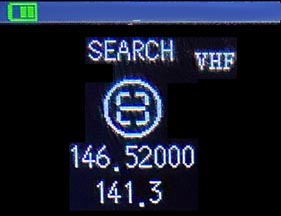One Touch
Frequency Search
Understanding the Option


|
What is
Frequency Search
The Frequency Search option allows the handheld operate
as a frequency counter. It will display both the
frequency and CTCSS/DCS tone of a nearby transmitter.
This information can now be used to enter channels into
the transceiver.
The handheld used in this example is a BTech F8HP PRO.
Other models may vary slightly.
How to Activate
- Press and Hold the
V/M key on the front panel to
enter the Search / Seek
frequency counter mode.
At this time you will need to select the Band of the
desired signal. The displayed options are: VHF, 200,
350, UHF as shown above. This is done with a short press of
either the A/B
or # key.
The receiver is now a detector of close
signals. When a strong nearby signal is found, the
Frequency and, if present, a CTCSS/DCS code will be displayed.
Off Frequency
The example below shows a signal from a radio set for
146.520 MHz but transmitting 250 Hz lower in frequency.
When programming your radio, use the correct 146.520,
not 146.51975 MHz as well as the 141.3 CTCSS tone being
received.
Note: It's possible that the signal from the incoming
radio might be a bit off frequency, but always program
your radio correctly.
Repeater Channel
If a handheld is transmitting on a repeater channel,
remember this is the Repeater's input frequency. You
must adjust the offset difference when programming your
radio.
Programming Example
If the scanning result shows 467.550 with a tone of
141.3, the channel setup should be:
Your Rx = 462.550
Your Tx = 467.550
CTCSS = 141.3
This will reflect the 5 MHz frequency offset used by the
repeater as well as the CTCSS access tone.
Saving the information
- Press the Select button
(House icon) on the keypad. The channel numbers will
be shown.
Channels shown as CH-xxx are channels that have current
channel
information already programmed. Those with just the
channel number are empty channel slots.
Example:
CH-010
CH-011
012 (empty channel)
013 (empty channel)
-
Using the Arrow keys, walk the cursor to an empty
channel and press Select. The frequency and tone data
will now be saved for future use. Using your software,
you will be able to adjust the information to create a
new permanent channel.
Sensitivity
Although the receiver sensitivity is reduced in this mode, I
am still able to detect a local repeater about a half mile
away and display both the Frequency and Tone.
|
| |
|
|